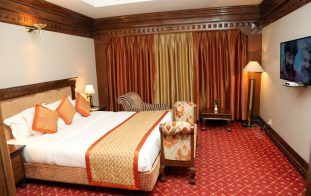

About Hotel Mountview
Sector-10, Chandigarh.
Hotel Mountview has been an icon on the landscape of City Beautiful for many decades; with reputation of taking care of our guest like no other. Nestled in the back drop of Shivalik Hills, the sense of calm that pervades the outdoor space is carried into the classically appointed rooms and suites. Fine dining space, exquisite banqueting venue and a spa ensure that all you need is available.
Contemporary comforts, a pleasant atmosphere with personalized services are the perfect ingredients that make this hotel a preferred, fascinating place to stay. Each of the hotel’s 145 rooms and 10 suites are individualistic in decor and style. whatever your preference, You shall find whatever you are looking for, bask in the sun amidst lush green lawns and majestic trees with the backdrop of resplendent hills or simply doing nothing at all in exquisite surroundings.
Particulars | Specifications |
|---|---|
Area of Hotel | 6.5 Acres |
Classification of Rooms | |
|---|---|
Royal Suite | 10 |
Executive | 23 |
Deluxe | 122 |
Detail of Restaurants | |
|---|---|
Round the Clock | 100 Covers |
Magic Wok Chinese Restaurant | 80 Covers |
Vintage Bar | 38 Covers |
Detail of Banquet Halls | |
|---|---|
Back Lawn | Upto 1000 Pax capacity |
Front Lawn | Upto 800 Pax capacity |
Confluence Hall | Upto 300 Pax capacity |
Ball Room | Upto 150 Pax capacity |
AT A GLANCE

hotel attractions
Round the Clock
Coffee Shop (Lobby Level)
Craving a cup of Jawa or just aching for something special?
Round the Clock is our 24 x 7 coffee shop. It offers specially curated cuisine that can be enjoyed at all times. Culinary highlights include Grand Buffet Breakfast, Buffet Lunch and Buffet Dinner. All complemented by uninterrupted view of lush green lawns and pool, topped off with our intuitive attention to your needs.


Vintage Lounge Bar
(Level 1 - Terrace)
Vintage Bar is the most fashionable place to relax over a drink with friends or business associates. The menu features premium domestic and international beverages, signature cocktails, rare single malts and carefully matched eclectic snacks. The open terrace area offers a breathtaking view of the green environs.
Timing: 11 am – 12 midnight
Magic Wok (Chinese Restaurant)
A Multi-Cuisine Restaurant (Level 5)
The 80 cover multi-cuisine Restaurant offers an option of mouth-watering rich gourmet fare of the Indian, Continental and Italian cuisines. Throughout the year, Magic Wok is a host to many food festivals like Punjabi, Arabic, Lakhnavi, Chandigarh to Chandni Chowk, Street food festival, where delectable food is served in an exquisite environment.


HOX Gym
Hox Gym, Chandigarh makes sure it satiates all your senses with its fitness programmes ranging from power packed boxing sessions to stress buster yoga sessions under one roof. They offer you a whole lot of stress buster packages supplemented with spa & beauty treatments.
Picture GALLERY
Special Rates on Online Bookings
Tariff/ Taxes subject to change without notice.
*Taxes as applicable
ACCOMMODATION & AMENITIES
Tea / coffee makers in rooms
FREE WIFI
Outdoor Swimming Pool

ROUND THE CLOCK COFFEE SHOP
24-hours room service
Doctor on Call
Health fitness Gym
ROUND THE CLOCK COFFEE SHOP
MAGIC WOK (CHINESE RESTAURANT)
Daily housekeeping
NEAR BY
- Rose Garden: 1.5 KM
- Rock Garden: 2.5 KM
- ISBT Sector 17: 3.3 KM
- Sukhna Lake: 5 KM
- ISBT Sector 43: 7 KM
- Elante Mall: 7.2 KM
- Railway Station: 10.6 KM
- International Airport: 23 KM











